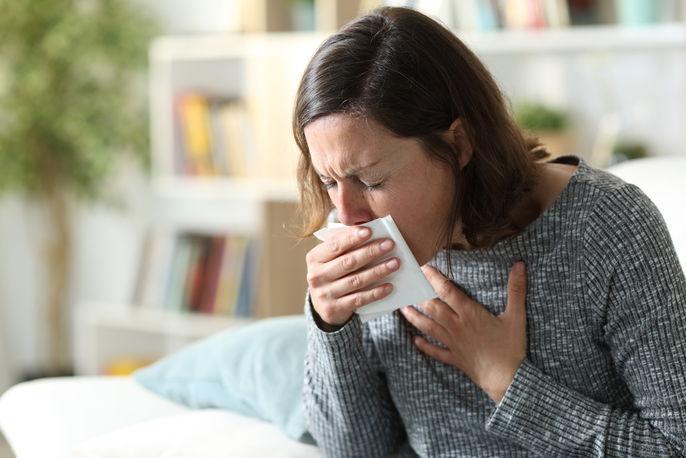Hemoptysis, or spitting-up blood, can be a sign of airwau infection or inflammation, which can occur with conditions like bronchitis or bronchiectasis. It can also be the result of a blow to the mouth or nose, or an oral condition, like gingivitis.
In some cases, hemoptysis may be accompanied by other symptoms, such as difficulty breathing, chest pain, tiredness, bad breath and swollen gums.
Therefore, if you are spitting up blood on a frequent basis, if it does not improve over time and/or it presents with other symptoms, you are advised to consult your doctor for assessment and treatment as needed.

Why am I spitting up blood?
The common causes of hemoptysis include:
1. Gingivitis
Gingivitis is one of the most common causes that lead to spitting-up blood. It is particularly noticed after brushing the teeth, as this is when the gums are most sensitive and weak from bacterial plaque build-up between the teeth. In addition to bleeding, people with gingivitis may also experience gum pain, bad breath, redness and swollen gums.
What to do: In this case, it is important to consult a dentist to ensure the oral cavity is thoroughly clean and that all built-up plaque is removed. Fluoride should tend be added to the teeth for extra protection. To maintain oral hygiene, you should brush your teeth 3 times per day and floss regularly to prevent further episodes of gingivitis.
Read about other home remedies for gingivitis to help reduce gum swelling.
2. Anticoagulant use
Anticoagulant medication, like warfarin, rivaroxaban or heparin, for example, blood clot formation by inhibiting the release or action of substances needed to form clots It is normal for people who take these medications to experience bleeding more easily and to stop bleeding when they are injured. Even small mouth wounds can lead to hemoptysis.
What to do: It is important to inform the doctor of any side effects you may notice after starting a medication, including blood in the your phlegm or saliva. The doctor will assess the need to discontinue the medication or to swap it for another.
3. Nose bleeds
In some cases, nose bleeds can lead to blood dripping into the mouth, especially if you lean your head backwards to get it to stop. Nose bleeds can be caused by injuries, high blood pressure, foreign bodies in the nostrils, low platelets, a deviated septum or sinusitis. Read more about what causes nose bleeds and what you can do to resolve them.
What to do: To stop a nose bleed, you are advised to pinch your nose until it subsides. You should see a doctor if it happens frequently, however, as other methods may be needed. Depending on the cause, the doctor may recommend medication, nasal sprays or the removal of any trapped objects.
4. Bronchitis
Bronchitis is characterized by the inflammation of the bronchi. It can cause symptoms like coughing, shortness of breath, phlegm with blood, wheezing or crackles when breathing, blue lips or finger tips, or leg swelling. Persistent coughing can lead to dryness in the throat, which may result in hemoptysis.
What to do: In this case, you should see a doctor to diagnose the type of bronchitis present, as this will ultimately guide treatment. Treatment may include the use bronchitis medication like analgesics, expectorants, antibiotics, bronchodilators or corticosteroids.
Also recommended: 10 Home Remedies for Bronchitis (Natural Recipes to Try) tuasaude.com/en/home-remedies-for-bronchitis5. Bronchiectasis
Bronchiectasis is a pulmonary disease that causes symptoms like coughing with or without blood, shortness of breath, general malaise, chest pain, bad breath and fatigue. This disease occurs due to a permanent dilation of the bronchi and bronchioles, which can happen with recurrent bacterial infections, obstruction of the bronchioles by foreign bodies, or genetic diseases (like cystic fibrosis).
What to do: Bronchiectasis is not curable and treatment is aimed at improving symptoms and reducing progression of the illness. The doctor may prescribe antibiotics, mucolytics and expectorants to help release respiratory discharge, as well as bronchodilators to ease breathing.
6. Tuberculosis
Tuberculosis is an infectious disease caused by Mycobacterium tuberculosis bacteria. This bacteria enters the lungs and multiples, leading to symptoms like pain, difficulty breathing, cold sweats, low-grade fever and coughing with blood. The emergence of blood is actually one of the main symptoms associated with tuberculosis.
What to do: If you notice coughing with blood, you should proceed to the emergency room, so that further testing can confirm a diagnosis and treatment can be started.
Treatment for tuberculosis should be guided by a doctor and involves the use of antibiotics to eliminate the bacteria. Antibiotics should be taken as directed by a doctor even after symptoms have disappeared so that a complete cure can be ensured.
7. COPD
Chronic obstructive pulmonary disease (COPD) is a respiratory disease characterized by inflammation and damage within the lungs. It is associated with symptoms like shortness of breath, cough phlegm (which may or may not be blood-tinged), and difficulty breathing.
Learn more about COPD and complete our online symptom checker to determine your risk for this condition.
What to do: There is no cure for COPD, however symptoms can be alleviated by adopting a healthy lifestyle, respiratory physio, and using medications (like bronchodilators, corticosteroids or expectorants).
Also recommended: Coughing Up Mucus: 9 Common Causes (& How to Treat) tuasaude.com/en/wet-cough8. Pulmonary embolism
A pulmonary embolism (PE) is when a blood vessel in the lungs becomes blocked by a blood clot,, leading to decreased blood flow and tissue death if left untreated. This condition can cause symptoms like sharp chest pain when breathing, shortness of breath and hemoptysis.
What to do: A PE must be treated urgently to avoid further complications. The doctor will typically prescribe anticoagulants to break-up the clot, analgesics to relieve chest pain, and if necessary, an oxygen mask to restore blood oxygen levels.






























